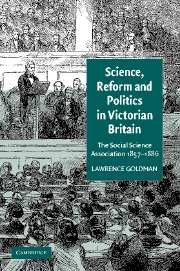Book contents
- Frontmatter
- Contents
- List of illustrations
- Acknowledgements
- Note on citations in the text
- List of abbreviations
- Introduction: the contexts of the Social Science Association
- Part I POLITICS
- Part II REFORM
- Chapter 4 Liberalism divided and feminism divided: women and the Social Science Association
- Chapter 5 Transportation, reformation, and convict discipline: the Social Science Association and Victorian penal policy 1853–1871
- Chapter 6 Victorian socio-medical liberalism: the Social Science Association and state medicine
- Chapter 7 Labour and capital: the Social Science Association, trade unionism, and industrial harmony
- Chapter 8 The Social Science Association and middle-class education: secondary schooling, endowments, and professionalisation in mid-Victorian Britain
- Chapter 9 The Social Science Association and the making of social policy
- Part III SCIENCE
- Part IV DECLINE
- Conclusion: The Social Science Association and social knowledge
- Appendix I The founders of the Social Science Association, 29 July 1857
- Appendix II Social Science Association Congresses, 1857–1884
- Appendix III Presidents of the Social Science Congresses, 1857–1884
- Appendix IV Departmental presidents, 1857–1884
- Select bibliography
- Index
Chapter 7 - Labour and capital: the Social Science Association, trade unionism, and industrial harmony
Published online by Cambridge University Press: 22 September 2009
- Frontmatter
- Contents
- List of illustrations
- Acknowledgements
- Note on citations in the text
- List of abbreviations
- Introduction: the contexts of the Social Science Association
- Part I POLITICS
- Part II REFORM
- Chapter 4 Liberalism divided and feminism divided: women and the Social Science Association
- Chapter 5 Transportation, reformation, and convict discipline: the Social Science Association and Victorian penal policy 1853–1871
- Chapter 6 Victorian socio-medical liberalism: the Social Science Association and state medicine
- Chapter 7 Labour and capital: the Social Science Association, trade unionism, and industrial harmony
- Chapter 8 The Social Science Association and middle-class education: secondary schooling, endowments, and professionalisation in mid-Victorian Britain
- Chapter 9 The Social Science Association and the making of social policy
- Part III SCIENCE
- Part IV DECLINE
- Conclusion: The Social Science Association and social knowledge
- Appendix I The founders of the Social Science Association, 29 July 1857
- Appendix II Social Science Association Congresses, 1857–1884
- Appendix III Presidents of the Social Science Congresses, 1857–1884
- Appendix IV Departmental presidents, 1857–1884
- Select bibliography
- Index
Summary
The legitimacy and place in society of trade unionism became a compelling issue in the third quarter of the nineteenth century as the law, economic theory, business practice, and the political system were obliged to accommodate the development of large-scale craft-based trade unions. The mid-century social ‘equipoise’ encouraged a more moderate approach to working-class institutions of all types: the SSA was itself taken to represent a new age of class harmony. The acceleration of popular politics in the 1850s and the extension of the franchise in the 1860s forced both parties to acknowledge the existence of a politically conscious section of the working class, largely associated with trade unionism, and compete for its votes. For their part, unions developed sound internal organisation and finance and institutionalised themselves at local and national levels through the development of trades' councils and the Trades Union Congress. In complex social and political interactions the substantive legal and political achievements of the unions were gained with the acquiescence, if not enthusiastic support, of both political parties. In the process, however, trade unions were encouraged to accept dominant social and economic values. The Social Science Association was prepared to recognise the advance of trade unionism, but it sought leave, in recompense, to impose on the unions a series of expedients for industrial harmony calculated to limit their functions and influence.
- Type
- Chapter
- Information
- Science, Reform, and Politics in Victorian BritainThe Social Science Association 1857–1886, pp. 201 - 235Publisher: Cambridge University PressPrint publication year: 2002



